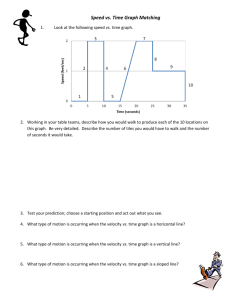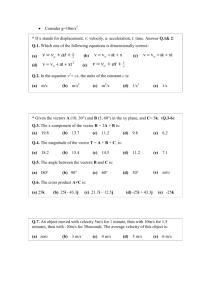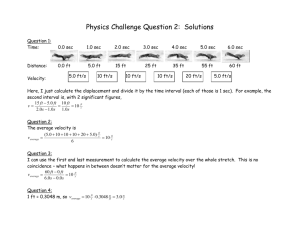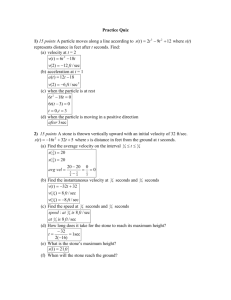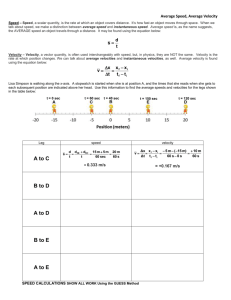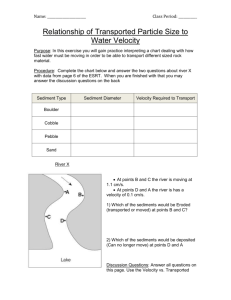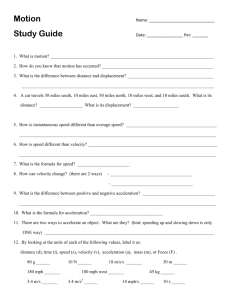Modeling with Integrals as Net Change
advertisement
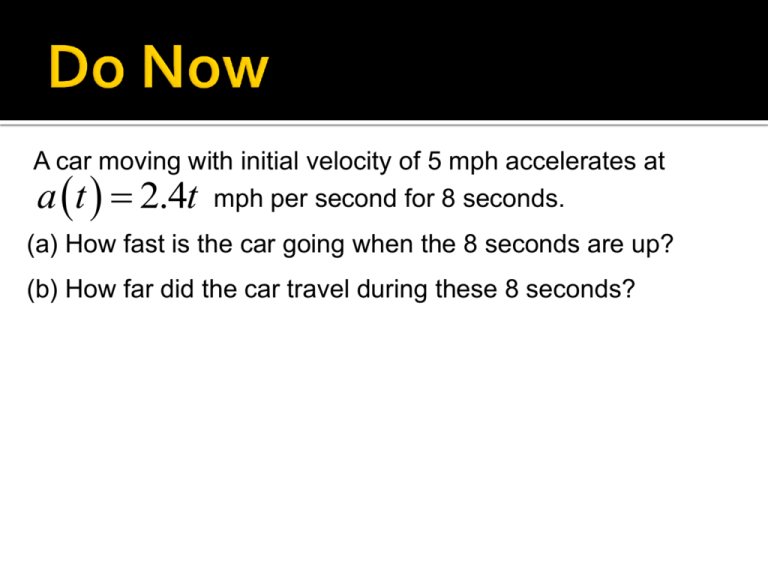
A car moving with initial velocity of 5 mph accelerates at a t 2.4t mph per second for 8 seconds. (a) How fast is the car going when the 8 seconds are up? (b) How far did the car travel during these 8 seconds? Section 7.1b The integral is a natural tool to calculate net change and total accumulation of more quantities than just distance and velocity (ex: growth, decay, consumption, acceleration). Whenever you want to find the cumulative effect of a varying rate of change, integrate it!!! A car moving with initial velocity of 5 mph accelerates at a t 2.4t mph per second for 8 seconds. (a) How fast is the car going when the 8 seconds are up? Net velocity change: mph 1.2t 76.8 a t dt 2.4 tdt 0 0 0 8 8 2 8 Final velocity after 8 seconds: Initial velocity + Net velocity change 5 76.8 81.8 mph A car moving with initial velocity of 5 mph accelerates at a t 2.4t mph per second for 8 seconds. (b) How far did the car travel during these 8 seconds? Velocity function: 1.2t 2 5 mph Distance traveled: 8 0 v t dt 1.2t 5 dt 0.4t 5t 0 0 244.8 mph x sec 8 244.8 mi x sec 1 hr 3 2 x 1 hr 3600 sec 0.068 mi 8 The graph of the velocity of a particle moving on the x-axis is given below. The particle starts at x = 2 when t = 0. (a) Find where the particle is at the end of the trip. (b) Find the total distance traveled by the particle. v (m/sec) Final position: 2 v t dt 2 0.5 2 3 10 3 0 t (sec) 10 –3 0.5 1 3 3 3 0.5 1 3 0.5 33 2.5 meters The graph of the velocity of a particle moving on the x-axis is given below. The particle starts at x = 2 when t = 0. (a) Find where the particle is at the end of the trip. (b) Find the total distance traveled by the particle. v (m/sec) Total distance: 3 10 0 t (sec) 10 –3 v t dt 0.5 2 3 0.5 1 3 3 3 0.5 1 3 0.5 33 19.5 meters From 1970 to 1980, the rate of potato consumption in a particular country was C t 2.2 1.1t millions of bushels per year, with t being years since the beginning of 1970. How many bushels were consumed from the beginning of 1972 to the end of 1973? We need the cumulative effect of the consumption rate for 2t 4 Consumption: 4 C t dt 2.2 1.1 dt 4 t 2 2 Evaluate numerically: NINT 2.2 1.1 , t , 2, 4 7.066 million bushels t Suppose that the average rate of electricity consumption for a certain home is modeled by the given function, where C(t) is measured in kilowatts and t is the number of hours past midnight. Find the average daily consumption for this home, measured in kilowatt-hours. Consumption: 24 0 C t 3.9 2.4sin t 12 28.8 t t 3.9 2.4sin 12 dt 3.9t cos 12 0 24 93.6 kilowatt-hours Oil flows through a cylindrical pipe of radius 3 in, but friction from the pipe slows the flow toward the outer edge. The speed at which the oil flows at a distance r in from the center is 8 10 r 2 inches per second. (a) In a plane cross section of the pipe, a thin ring with thickness r at a distance r inches from the center approximates a rectangular strip when you straighten it out. What is the area of the strip (and hence the approximate area of the ring)? Width r Area Length 2 rr 2 r Oil flows through a cylindrical pipe of radius 3 in, but friction from the pipe slows the flow toward the outer edge. The speed at which the oil flows at a distance r in from the center is 8 10 r 2 inches per second. (b) Explain how we can find the rate at which oil passes through this ring. Volume per sec. = Inches per sec. x Cross section area 3 in in 2 8 10 r 2 2 r r in = flow in sec sec Oil flows through a cylindrical pipe of radius 3 in, but friction from the pipe slows the flow toward the outer edge. The speed at which the oil flows at a distance r in from the center is 8 10 r 2 inches per second. (c) Set up and evaluate a definite integral that will give the rate (in cubic inches per sec) at which oil is flowing through the pipe. 8 10 r 2 r dr 16 10r r dr 3 3 2 0 3 0 3 in in 2 1 4 1244.071 16 5r r 396 sec sec 4 0 3 3 In science, the term work refers to a force acting on a body and the body’s subsequent displacement. When a body moves a distance d along a straight line as a result of the action of a force of constant magnitude F in the direction of the motion, the work done by the force is W Fd This is called the constant-force formula for work. Units of work are force x distance. In the metric system, the unit is Newton-meter (called a Joule); in the U.S. customary system, the most common unit is the foot-pound. Hooke’s Law for springs says that the force it takes to stretch or compress a spring x units from its natural (unstressed) length is a constant times x. In symbols: F kx where k, measured in force units per unit length, is a characteristic of the spring called the force constant. Another important note: Numerically, work is area under the force graph!!! It takes a force of 10 N to stretch a spring 2 m beyond its natural length. How much work is done in stretching the spring 4 m from its natural length? First, we need to find the “force equation” for this particular spring: F x kx F 2 10 k 2 k 5 N m F x 5x for this particular spring It takes a force of 10 N to stretch a spring 2 m beyond its natural length. How much work is done in stretching the spring 4 m from its natural length? Now, we construct an integral for the work done in applying F over the interval from x = 0 to x = 4: 4 4 4 2 0 5 F x dx 5xdx x 40 N m 0 2 0
